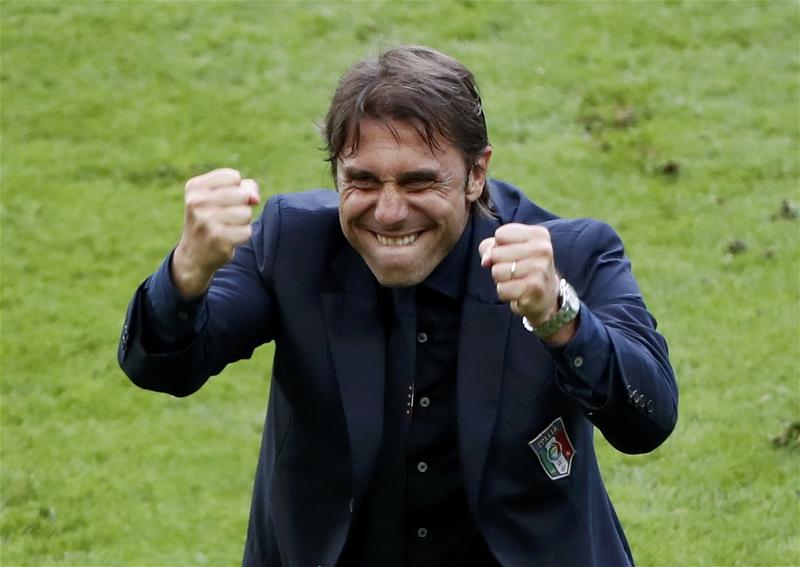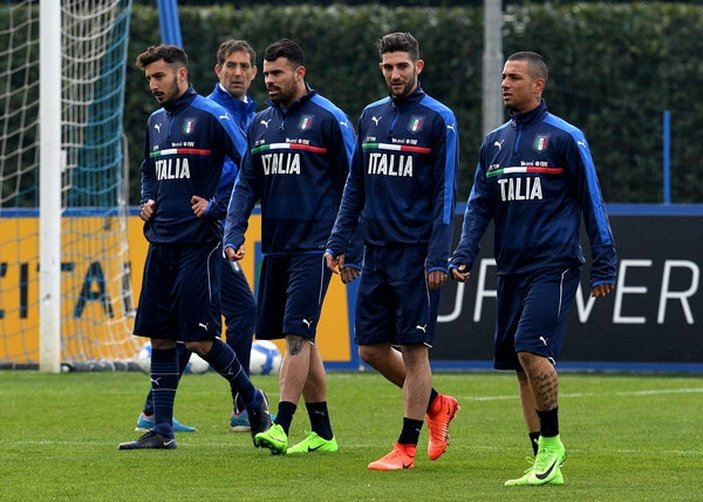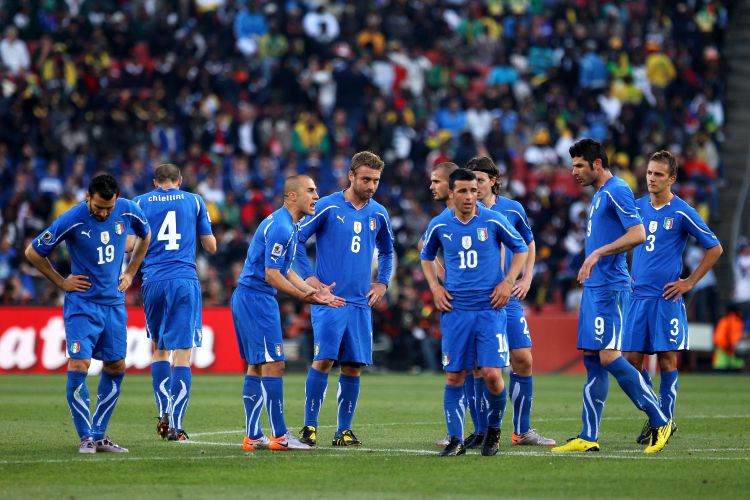On 9 July 2006 inside Berlin’s Olympiastadion, 120 minutes of football were not enough to decide a victor between Italy and France. In the resultant penalty shoot-out, holding the hopes and dreams of a country in his left boot, defender Fabio Grosso confidently converted his penalty, leaving Fabien Barthez hopeless. Back in Rome there was pandemonium at the Piazza Venezia as locals celebrated a fourth World Cup victory.
At the time, the shadow of the Calciopoli scandal loomed large over Italian football, but the Azzurri could not have done a better job alleviating the domestic embarrassment. Throughout the tournament, the Italians – led by Ballon d’Or-winning captain Fabio Cannavaro – had pulled together and when necessary, deployed their famed Catenaccio tactics—“door bolt football” as it is literally translated.
Perhaps this side, with their blend of experience, cunning and skill, could continue to prevail in years to come. Three days after lifting the World Cup, however, Lippi elected not to renew his contract. The Italian Football Federation (FIGC) assigned former AC Milan legend, Roberto Donadoni the role and tasked him with readying the troops for 2008’s European Championships in Austria and Switzerland. Behind a World Cup victory, a winning core remained intact – albeit under new rule. Lingering wounds from Calciopoli slowly began to heal. Boasting many of the same faces from Germany, Italy supporters were positive about their chances heading into the opening match with Marco van Basten’s Netherlands. But following a humbling 4-1 defeat to the Dutch, Donadoni’s men would recover, advancing to the knockout phase before bowing out to Spain on penalties.
Ironically, La Roja’s Euro 2008 triumph heralded the dawn of a Spanish golden era, while halting Italy’s in its tracks. Donadoni’s consequent dismissal prompted the Federation to re-appoint Lippi. The Viareggio-born tactician has the near impossible ask of following-up 2006’s masterpiece at the World Cup in South Africa. But, rather than invigorating the squad with fresh faces, Lippi remained faithful to the old guard. On paper, this ideology made sense. Except, four years in football terms is an eternity. As it turned out, Italy’s shortsightedness in not recognising football’s cyclical nature ultimately led to their demise. By placing such enormous responsibility and expectation on ageing stars, like the then 36-year-old Cannavaro, they were headed for disaster. Dismal performances against the likes of Paraguay, Slovakia and New Zealand forced a reality check. Italy went crashing out of the group stage.
Experts and media depict the future landscape of a national side partly based on their current standing at club level. Around the time of the 2010 World Cup, Italian football’s most prestigious clubs gradually slipped into a sudden state of obscurity. Juventus were still struggling post Calciopoli, though it wouldn’t be long until their emphatic revival started showing signs of beginning. AC Milan’s troubles after their Scudetto in 2011 forced an exodus of major stars. Inter failed to build on the success of Jose Mourinho’s glorious treble-winning season, and similarly to the national team, the club kept faith in the old guard for far too long. Meanwhile, Napoli and Roma failed to make the leap in European competition that some hoped they would. Thus, like the National Team, the domestic league was struggling.
The 2010 World Cup was a bitter failure for the Azzurri.
Indeed, after the debacle in South Africa, it took two years for shoots of revival to appear. Coached by ex-Fiorentina boss Cesare Prandelli, Italy enjoyed a run to the final of Euro 2012, beating England and Germany along the way.
The young and often misunderstood star striker, Mario Balotelli, tormented Joachim Löw’s Germans, scoring two goals and flexing his muscles (literally) for the all the world to see. Balotelli’s exploits under the bright lights of his first major tournament breathed new life into the Azzurri. To their dismay, however, Italy once again ran into a Spanish buzzsaw, and were comfortably beaten in the final. Yet there was no doubting Prandelli’s progress with the national side.
A year later, there was further cause for optimism at the UEFA U-21 European Championship in Israel. Once again, Italy advanced to the final, inspired by coach Devis Mangia and his talented crop of ‘protagonisti’, including Lorenzo Insigne, Ciro Immobile, Alessandro Florenzi, Manolo Gabbiadini and one of the world’s best midfield technicians, Marco Verratti. But once again, Italy fell short, bested by a familiar Spanish foe.
As such, by the time the 2014 World Cup arrived, Italy appeared to be on the right track. Prandelli balanced his squad with rising stars like Verratti, Insigne and Immobile, while still keeping his faith in elder statesmen like Gianluigi Buffon and Daniele De Rossi. In the buildup, expectations were predictably mixed. Azzurro hearts believed in a renaissance, but minds forecasted further heartache. These doubts were temporarily vanquished after a 2-1 victory over England in italy’s opening group game. But just like four year previous, the wheels fell off against the so called smaller teams, as Italy lost to Costa Rica and Uruguay. Consecutive group stage exits provoked plenty of soul search and once again, controversial FIGC President Carlo Tavecchio made another change at the helm.
Prandelli resigned and in stepped Antonio Conte. Domestically, the Lecce native had masterminded Juventus’ return to the summit of Italian football, winning three consecutive league titles before taking up the Italy post. Recognised around Europe as a meticulous man-manager, Conte’s tactical acumen was exactly what Italy needed.
Click to read ‘Antonio Conte and Juventus: The Anatomy of a Renaissance
The fiery and irrepressible winner changed the landscape of the team. Although the talent level of his Euro 2016 squad was questioned and doubted at every turn, Conte was not perturbed. He wanted 23 warriors who would suffer for one another, and that’s exactly what he selected. The squad embraced his philosophy, including inexperienced players at international level like Emanuele Giaccherini, Federico Bernardeschi, and Mattia De Sciglio. After cathartic victories against Belgium and most significantly, Spain, Italy’s spirited effort fell short in the quarter-finals, losing to Germany on penalties. But Conte’s men drew considerable praise and, perhaps more importantly, had restored Italian pride. For the first time in a while, fans of the Azzurri felt there was a new vision and purpose.Speaking to Sky Italia upon arriving at Cobham Training Centre outside London, Conte discussed his coaching philosophy, saying:
“The word ‘coach’ has to encompass everything. You can’t only be good at tactics, just as you can’t only be good at motivation, just as you can’t only be good from a psychological point of view, just as you can’t only be good in how you manage the club and the media…You have got to try and excel at everything.”
Conte’s successor would need a similar mentality and pedigree to continue his work. Tavecchio explored his options, but ultimately sided with journeyman coach Gian Piero Ventura.
Ventura had become part of the fabric in Italy, but from a philosophical perspective, he has a claim to being considered the most forward thinking Azzurri coach in recent memory. The 69-year-old warhorse has managed at every level in Italy, Unlike Conte, who tended to shy away from placing faith in youth during his two years on the bench, Ventura imagines an Italy side full of starlets. Tactically, the changes have not been radical.
But the most striking contrast can be found in Ventura’s belief, his understanding, that in order to compete with the likes of Germany, Spain and France, there must be a commitment to a project – including the integration of youngsters. The average age of Italy’s squad at Euro 2016 was 29, which speaks for itself. That has all changed under Ventura, who has forgone selecting individuals based on experience and reputation, and places more emphasis on what they can provide now and in the future. For example, personal favourites of Conte, such as Emanuele Giaccherini and Graziano Pelle, have outlived their stay.
Of course, Ventura has not abandoned the most dependable members of the old guard, and he would be foolish to do so. Few nations have enjoyed the luxury of an unwavering stalwart like Buffon in goal. Having spent over 20 years as Italy’s number one, the Juve captain remains the face of the National Team, and continues to be an example for all, including his pre-destined heir: AC Milan wonderkid Gianluigi Donnarumma.
Defensively, the Bianconeri trio of Bonucci, Barzagli and Chiellini has proven highly dependable, although their window of opportunity to achieve national glory is closing. That being said, the future also looks bright in the defensive positions. Combining a unique mixture of technical ability and solidity, Alessio Romagnoli, Daniele Rugani and Mattia Caldara – all 22 years of age — could step in immediately. Moving into the midfield, Verratti is well-suited to fill Pirlo’s role in the front of the defense for the next decade, while Inter’s Roberto Gagliardini (22) has rapidly risen through the ranks. Finally, after years of uncertainty in the attacking positions, the Azzurri look to have found the answers.
Prior to the 2016-17 season, few outside the Italian peninsula had heard of Andrea Belotti, or the Rooster as he is known. But his domestic form with Torino has ensured he now holds an astronomical €100 million release clause in his contract, sitting at the top of several top club’s shopping list. Flanking the 24-year old striker, are the likes of Insigne, Bernardeschi and Sassuolo’s tenacious winger Domenico Berardi.
‘The Rooster’ has established himself as Italy’s most prolific striker.
The recent years of disappointment for Italy allowed a short-sighted approach to take hold. But as we know, football is more than tactics, players and personalities. The success of a nation is directly related to its domestic product, invention of new ideas and sustainability. Calcio has recently altered its thinking towards developing youth. In the past, there were few clubs making a conscious effort to incorporate home-grown talents, opting instead to spend money on foreign talent.Now, the organisational structures of squads such as Sassuolo, Sampdoria and Atalanta have been underpinned by a desire to integrate their Primavera players, rather than ship them out on loan. By inheriting this thinking, we are witnessing a revolution, which encompasses the leagues beyond Serie A. Even the quality of players in Serie B no longer consider it a wasteland, but rather a place to earn significant playing experience.
Ahead of the Azzurri’s crucial World Cup qualifier with Albania, Ventura spoke outside Coverciano, stressing the importance of youth:
“I’ve said for some time that there’s a lot of good young players within the national team set-up. To qualify, we need some youth. [Alex] Meret’s selection is designed to give a signal of continuity, to demonstrate that those in the Under-21s should be aiming to reach the senior side through their performances.”
Slowly but surely, fresh faces and new methods have begun the process of reforming an Italian national side which looks to have potential in abundance. Journeys happen over time, not overnight. And with this injection of youth and creativity, perhaps the Azzurri’s glory days will no longer be a nostalgic memory, but instead relived through the new generation.
As the World Cup in Russia approaches, a sleeping giant has seen the light and is ready to step out of the shadows once again.
Words by Matthew Santangelo @Matt_Santangelo
Matthew is an Italian football writer who co-founded the blog, Milan Brothers. He is also an editor and columnist at Italian Football Daily.



